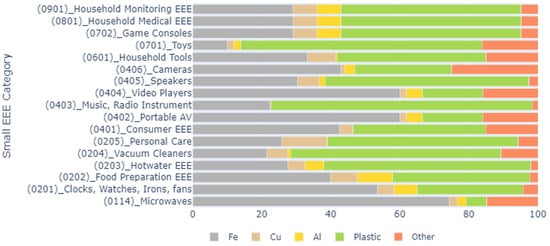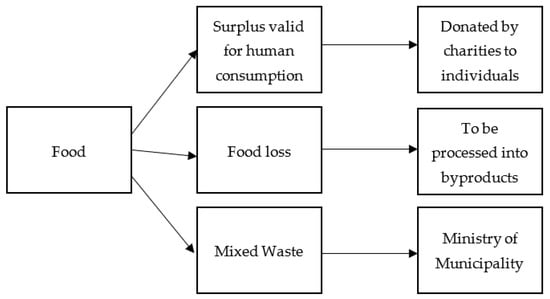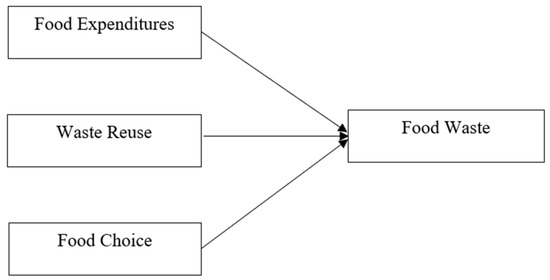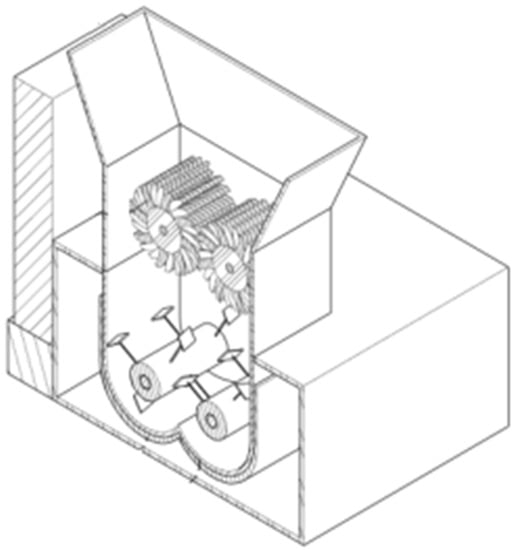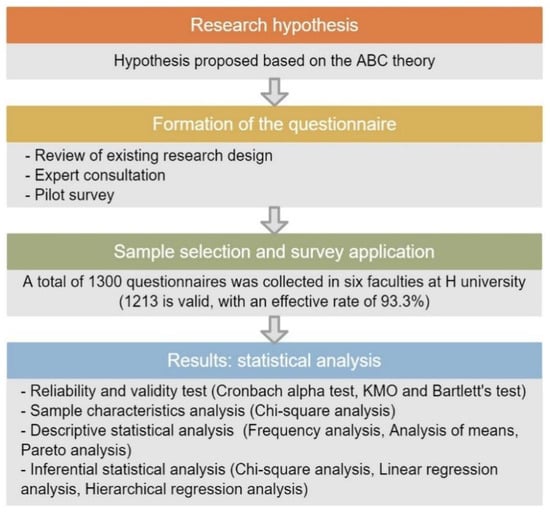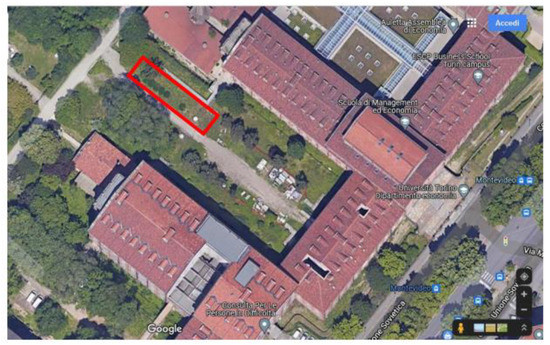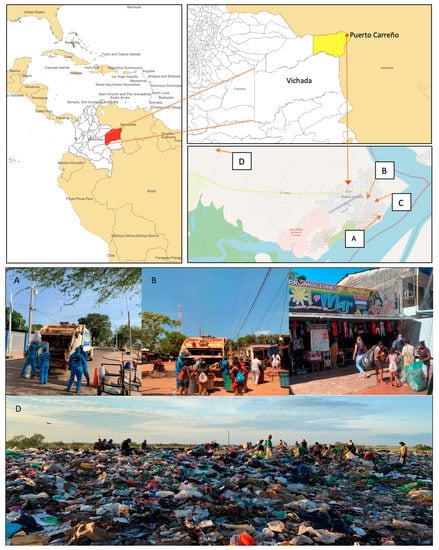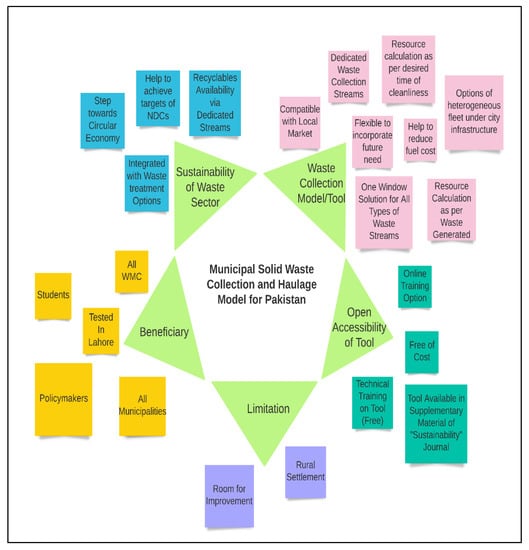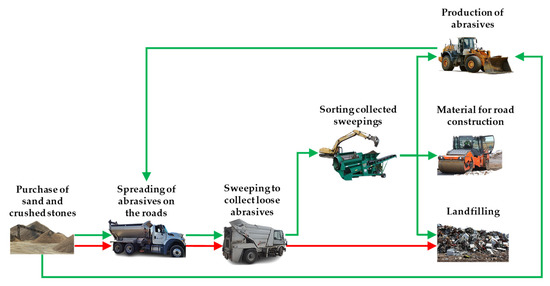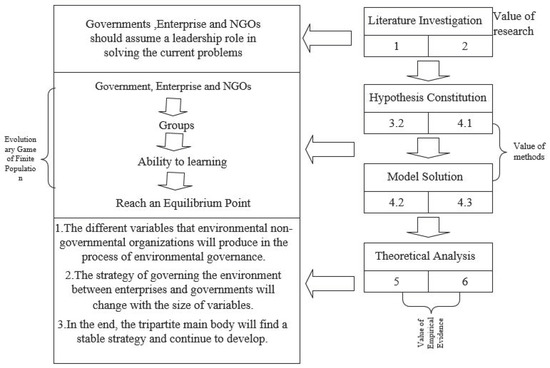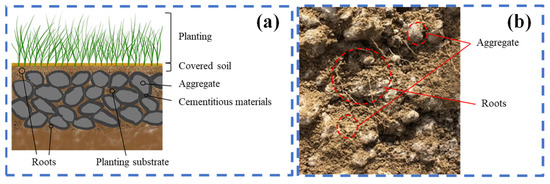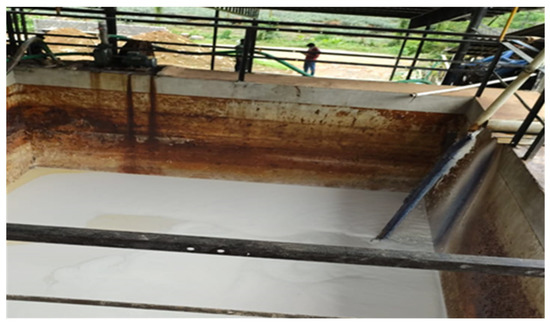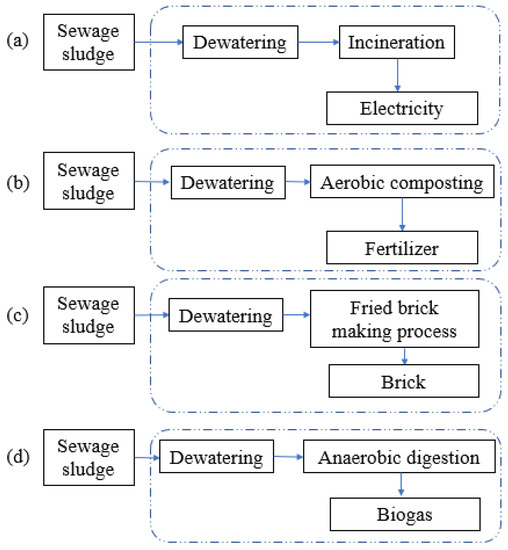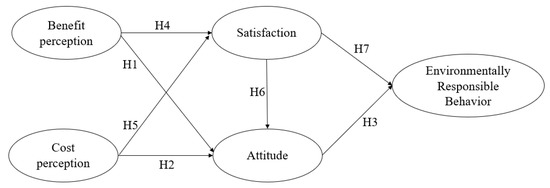Waste Management towards a Circular Economy Transition
A project collection of Sustainability (ISSN 2071-1050). This project collection belongs to the section "Waste and Recycling".
Papers displayed on this page all arise from the same project. Editorial decisions were made independently of project staff and handled by the Editor-in-Chief or qualified Editorial Board members.
Viewed by 58273
Share This Project Collection
Editors
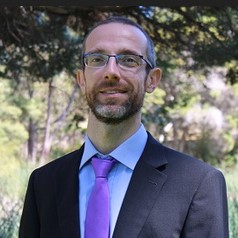 Dr. Simone Domenico Scagnelli
Dr. Simone Domenico Scagnelli
 Dr. Simone Domenico Scagnelli
Dr. Simone Domenico Scagnelli
E-Mail
Website
Collection Editor
School of Business and Law, Edith Cowan University, Joondalup, WA 6027, Australia
Interests: sustainability assessment and reporting; circular economy; business model innovation; sustainable development; business policy; business strategy
Special Issues, Collections and Topics in MDPI journals
 Dr. Meisam Ranjbari
Dr. Meisam Ranjbari
 Dr. Meisam Ranjbari
Dr. Meisam Ranjbari
E-Mail
Website
Collection Editor
Department of Economics and Statistics “Cognetti de Martiis”, University of Turin, Lungo Dora Siena 100 A, 10153 Torino, Italy
Interests: circular economy; waste management; sustainable development; business model innovation; closed-loop supply chains; food supply chain; system dynamics; sustainability assessment; product-service systems
Project Overview
Dear Colleagues,
The circular economy debate has gained momentum among industries and research communities over the recent years. The transition from a linear economy to a circular economy model in every sector significantly requires the adoption of effective waste management policies, strategies, and actions. In this regard, initiatives to better position waste management activities and practices within the circular economy framework are of high importance.
This Project Collection, entitled "Waste Management Towards the Circular Economy Transition", aims at contributing to the domain with novel approaches, advancements, and practices in waste management systems towards the implementation of circular economy principles.
Research areas may include (but are not limited to) the following:
- Enabling the circular economy transition in the healthcare industry.
- Environmental impacts and lifecycle assessment of different waste streams in the circular economy arena.
- The bio-based sector potentials in implementing circular bioeconomy platforms.
- Food waste management in the circular economy.
- Municipal solid waste management in the circular economy.
- Plastic waste management in the circular economy.
- Construction and demolition waste management in the circular economy.
- E-waste management in the circular economy.
- Agricultural waste management in the circular economy.
- Waste biorefinery approaches in enabling circular economy platforms.
- Energy recovery from waste or waste valorization for a sustainable circular economy.
- Barriers to circular economy implementation in waste management systems.
- Circular economy adoption in waste management practices.
- Sustainability assessment of waste management systems.
- Waste management disclosure and sustainability reporting.
- The role of digitalization in enabling circular economy in waste management systems.
- Smart waste management systems towards a circular economy transition.
- The nexus of sustainability and circular economy in waste management.
- The COVID-19 pandemic implications for waste management.
- Consumers’ contribution to the nexus of waste management and circular economy.
- Waste minimization and prevention approaches to achieve circular economy goals.
- Technological advancements in the waste-to-energy domain from the circular economy point of view.
- Waste management initiatives to close supply chain loops.
Dr. Simone Domenico Scagnelli
Dr. Meisam Ranjbari
Collection Editors
Manuscript Submission Information
Manuscripts should be submitted online at www.mdpi.com by registering and logging in to this website. Once you are registered, click here to go to the submission form. Manuscripts can be submitted until the deadline. All submissions that pass pre-check are peer-reviewed. Accepted papers will be published continuously in the journal (as soon as accepted) and will be listed together on the collection website. Research articles, review articles as well as short communications are invited. For planned papers, a title and short abstract (about 100 words) can be sent to the Editorial Office for announcement on this website.
Submitted manuscripts should not have been published previously, nor be under consideration for publication elsewhere (except conference proceedings papers). All manuscripts are thoroughly refereed through a single-blind peer-review process. A guide for authors and other relevant information for submission of manuscripts is available on the Instructions for Authors page. Sustainability is an international peer-reviewed open access semimonthly journal published by MDPI.
Please visit the Instructions for Authors page before submitting a manuscript.
The Article Processing Charge (APC) for publication in this open access journal is 2400 CHF (Swiss Francs).
Submitted papers should be well formatted and use good English. Authors may use MDPI's
English editing service prior to publication or during author revisions.
Keywords
- circular economy
- circular business models
- circular supply chain
- closed-loop supply chain
- waste management
- waste minimization
- waste treatment
- municipal solid waste
- plastic waste
- food waste
- e-waste
- construction and demolition waste
- smart waste management
- biomass
- organic waste
- waste-to-energy
- sustainable development
- waste management reporting
- lifecycle assessment
- environmental sustainability
- resource efficiency
- waste hierarchy
Published Papers (21 papers)
Open AccessArticle
Repair and Reuse or Recycle: What Is Best for Small WEEE in Australia?
by
Gimhan Jayasiri, Sunil Herat and Prasad Kaparaju
Viewed by 659
Abstract
The global and Australian trends indicate a steady increase in the generation of small waste electrical and electronic equipment (WEEE), constituting 30% of global WEEE in 2019 with an expected 90% increase in Australia over the next 25 years. Given this fact, identifying
[...] Read more.
The global and Australian trends indicate a steady increase in the generation of small waste electrical and electronic equipment (WEEE), constituting 30% of global WEEE in 2019 with an expected 90% increase in Australia over the next 25 years. Given this fact, identifying the most suitable circular economy strategy is vital in managing this waste stream. Hence, followed by a review of the literature, a model was developed to assess the suitability of repair, reuse, and recycling of small electrical and electronic equipment (EEE) by considering the lifespan and products put on the market (PoM) as critical variables. Findings indicate that solely repairing and reusing products, without reducing PoM small EEE, minimally affects short-term waste reduction. A synergistic approach, combining high product reuse with reduced PoM small EEE, is essential to decrease small WEEE generation significantly. Regardless of lifespan changes, the study indicates a proportional relationship between small WEEE generation rates and PoM small EEE changes, emphasising the need for a holistic strategy. Considering this, within stewardship schemes, the primary focus should initially lie on repairing and repurposing small EEE, with the potential for expansion into recycling once sufficient infrastructure and achievable recovery goals are established. Original equipment manufacturers (OEMs) must shoulder substantial accountability, with a firm commitment to extended producer responsibility (EPR) even for historical products. The initial rollout could target four specific categories: toys, food preparation equipment, vacuum cleaners, and household tools, with the scope widening to encompass all categories following successful implementation.
Full article
►▼
Show Figures
Open AccessArticle
Circular Economy and Solid Waste Management: Connections from a Bibliometric Analysis
by
Wender Freitas Reis, Cristiane Gomes Barreto and Mauro Guilherme Maidana Capelari
Cited by 1 | Viewed by 1691
Abstract
The aim of this study is to conduct a meta-analysis of the research published between 2012 and 2022 on solid waste management (SWM) and the circular economy (CE) using bibliometrics. To this end, the Scopus and Web of Science (WoS) databases were used
[...] Read more.
The aim of this study is to conduct a meta-analysis of the research published between 2012 and 2022 on solid waste management (SWM) and the circular economy (CE) using bibliometrics. To this end, the Scopus and Web of Science (WoS) databases were used as sources of publications. Processing was conducted using the R language version 4.2.2 and the Bibliometrix software package version 4.1.2. A theoretical basis was built on the terms in order to present their interactions in the context of scientific debate. The results show that there is a need to create indicators to facilitate the evaluation of SWM. They can be identified from the data collected during the management process. Examples include the volume of material collected, operating costs, and recycling rates. Indicators are important in the waste management process because they help quantify the effectiveness of the management practices adopted, help to identify areas that need improvement, and make it possible to monitor the progress of work over time and the achievement of previously set targets. Two other important results are the maximization of the use of resources by increasing the useful life of the product and the emergence of new sustainable business models with recycling as a driving force. Finally, and perhaps the most disruptive discovery, is the integration of SWM and CE with blockchain technology to reduce the levels of waste production. This shows how new technologies can be used as partners in solving complex problems, such as solid waste (SW).
Full article
►▼
Show Figures
Open AccessArticle
An Evaluation of the Alignment of Surplus Food Recovery and Redistribution Technologies with the Circular Economy
by
Sana Abusin, Noor Al-Emadi and Brian Mandikiana
Viewed by 1530
Abstract
In Qatar, food security is a top research priority. The National Food Security Strategy (2018–2023) and the Qatar National Vision 2030 show evidence of policy support regarding food security. The United Nations Sustainable Development Goal (S.D.G.) 12.3 frames the basis of food waste
[...] Read more.
In Qatar, food security is a top research priority. The National Food Security Strategy (2018–2023) and the Qatar National Vision 2030 show evidence of policy support regarding food security. The United Nations Sustainable Development Goal (S.D.G.) 12.3 frames the basis of food waste reduction efforts. Our study aims to provide basic information for innovative mobile application development that addressed food insecurity and waste in Qatar. Furthermore, we discuss how such a technology and the proposed features align with the circular economy concept. The circular economy aims to prolong the useful life of materials and products to maximize resource value and reduce waste. In addition, we highlight the main potential benefits that various stakeholders in the Qatar economy could derive from the innovative surplus food recovery mobile application. The scope of this work is necessary given the diverse nature of the stakeholders involved in the surplus food recovery and redistribution industry. The innovation demonstrated significant solutions to many problems, and using them in the food sector could provide optimal solutions to manage/reduce food surplus waste and loss. The suggested platform differs from the existing food services application, as it closes the food circle and achieves the sustainable goals for a better environment and society for future generations. We conclude with suggestions concerning how public–private collaboration could help recover surplus food and reduce food loss.
Full article
►▼
Show Figures
Open AccessArticle
Life Cycle Assessment of Concrete Production within a Circular Economy Perspective
by
Roberto Cerchione, Francesco Colangelo, Ilenia Farina, Patrizia Ghisellini, Renato Passaro and Sergio Ulgiati
Cited by 5 | Viewed by 1868
Abstract
The pursuit of sustainability in the construction and demolition (C&D) sector calls for effective decision-making strategies, both in terms of technical and environmental sustainability, capable of mitigating its huge demand for resources and emissions to the environment. The recycling of C&D waste is
[...] Read more.
The pursuit of sustainability in the construction and demolition (C&D) sector calls for effective decision-making strategies, both in terms of technical and environmental sustainability, capable of mitigating its huge demand for resources and emissions to the environment. The recycling of C&D waste is one of the potential solutions that could reduce the extraction of virgin materials as well as waste generation and landfilling. This study evaluates and compares, by means of the Life Cycle Assessment (LCA) approach, the production of concrete via five different mixtures made up of coarse natural aggregates (NA, primary, virgin materials), and coarse recycled concrete aggregates (RCA, recovered from previous uses). The present study assesses the environmental load of concrete production, by means of mixtures containing only coarse NA and mixtures with coarse RCA produced in fixed and mobile treatment plants, to be replaced with 30% and 100% of coarse NA by weight. The results point out that the use of coarse RCA in concrete mixtures provide greater energy savings and environmental advantages compared to the concrete with only coarse NA; the improvement increases up to a 100% replacement rate by weight of coarse NA with coarse RCA in the mixtures. In this case, the reduction of the impacts is significant for some impact categories such as freshwater ecotoxicity (−63.4%), marine ecotoxicity (−76.8%), human carcinogenic toxicity (−27.1%), human non-carcinogenic toxicity (−77.9%), land use (11.6%), and water consumption (−17.3%), while the total CED impacts decreases by about 10% and that of GWP by 0.4%. Results are discussed in light of the urgent need for advancing circular economy concepts and practices in the C&D sector and decrease the large use of primary resources (in particular sand and gravel). The replacement of NA with RA by weight could contribute to reducing the impacts of the C&DW management and disposal. For this to happen, further improvement of the quality of recycled aggregates is essential for their market development as well as dedicated policies and legislations.
Full article
►▼
Show Figures
Open AccessArticle
Household Food Waste Behavior in Klang Valley, Malaysia, and Its Potential in the Circular Economy
by
Zailin Zainal Ariffin, Siti Norazlin Anuar, Noor Farhana Mangadi, Azizul Yadi Yaakop, Zaini Sakawi, Sufian Jusoh and Mohd Adib Ibrahim
Viewed by 3195
Abstract
Food waste is a problem that has resulted in a variety of situations in which it is one of the primary causes of food insecurity. Changes in household behaviors, such as overbuying, are important drivers of food waste, particularly following the emergence of
[...] Read more.
Food waste is a problem that has resulted in a variety of situations in which it is one of the primary causes of food insecurity. Changes in household behaviors, such as overbuying, are important drivers of food waste, particularly following the emergence of COVID-19. Studies on what drives household consumer engagement in various food-waste strategies have been limited. Thus, this paper aims to study the factors that lead to food-waste behavior at the household level in the Klang Valley area. Out of the 431 questionnaires distributed, 404 were useful, and the respondents for this study were from various ethnicities. A quantitative design was employed in this study, with descriptive and inference statistics derived from the questionnaire, which was distributed via Google Forms. The data were analyzed using Statistical Package for Social Science version 26.0 and Smart PLS version 3.0, to test the reliability, validity, and hypotheses of this study. A significant relationship exists between food-waste behavior, namely food expenditure, and waste reuse, but food-waste behavior has no relationship with food choice. The study’s conclusions highlight the significance of understanding and planning one’s food-buying behaviors, to achieve benefits additional to simply lowering the number of those who are at risk of being hungry. The study also found that male respondents wasted more food than their female counterparts.
Full article
►▼
Show Figures
Open AccessArticle
Effects of Romanian Student’s Awareness and Needs Regarding Plastic Waste Management
by
Gratiela Dana Boca and Sinan Saraçli
Cited by 3 | Viewed by 2976
Abstract
The purpose of this study is to examine the effects of needs and awareness of university students on their environmental behaviour. With this purpose the data was collected from 537 students from the University of Cluj Napoca, Romania, from the engineering and management
[...] Read more.
The purpose of this study is to examine the effects of needs and awareness of university students on their environmental behaviour. With this purpose the data was collected from 537 students from the University of Cluj Napoca, Romania, from the engineering and management specializations respectively via an online questionnaire. The questionnaire was structured in four parts including 29 questions in total. The first part is meant to identify the students’ characteristics (gender, field of study, participation and attendance in field-specific activities, and if he/she is an environmentalist). The second part is meant to determine the students’ awareness regarding plastic and plastic pollution. Another part is meant to determine the needs of students and the manner in which they learn and gather information. The last part allows the determination of the students’ behavior in their daily life (use of bio plastic bags, environmental protection). The results show that students have enough information about biodegradable plastic but they act depending on the situation, respecting or not the rules for selecting plastic waste. The female student’ pay a lot of attention to selecting and choosing bioplastic products. The male students are directly involved in cleaning nature. Management students pay attention to small details as compared to engineering students who choose bioplastic even though the costs are higher. Related with their thoughts the factors effecting the opinion of either they are environmentalist or not are also examined. Being aware of the plastic waste show significant effect from the sides of awareness and behaviour. Finally, the structural model show that strongest connection is between students’ awareness about the plastic problem and the need to adapt to new regulations. Using the model universities can promote the importance of bioplastic through study programs or by involving students in volunteering activities, through their active involvement in environmental protection, and selective waste recycling.
Full article
►▼
Show Figures
Open AccessArticle
Consumer Willingness to Recycle The Wasted Batteries of Electric Vehicles in the Era of Circular Economy
by
Miaomei Guo and Weilun Huang
Cited by 3 | Viewed by 3104
Abstract
Electric vehicles (EVs) are increasingly being used for the benefit of the environment and to foster the development of a low-carbon circular economy. However, compared to internal combustion engine cars, spent EV batteries (WBEVs) constitute a different form of waste, and their recycling
[...] Read more.
Electric vehicles (EVs) are increasingly being used for the benefit of the environment and to foster the development of a low-carbon circular economy. However, compared to internal combustion engine cars, spent EV batteries (WBEVs) constitute a different form of waste, and their recycling mechanism is still in its early stages. WBEV consumer willingness to recycle is an issue in a circular economy in which EV users should be WBEV recycling pioneers. The purpose of this article is to develop an analytical model for consumers’ desire to return WBEVs for recycling, based on the circular economy and consumer welfare, in order to investigate consumer incentives for the construction of a WBEV recycling system. PLS-SEM was used for the analysis, and the results revealed the following. First, both the perception of government policy and environmental attitudes have significant positive causal effects on consumers’ intentions to recycle. Second, the perception of benefits has a significant positive mediating effect on recycling intention, whereas the perception of loss has a significant negative mediating effect. Third, the multigroup analysis found that, with the exception of gender, the variables of age, income, education, area of residence, recycling experiences, and EV ownership all have substantial moderating impacts, although their routes and directions vary considerably. Recycling policies must be appropriate for consumers, and this has policy consequences for the circular economy. Environmental education and incentives should be provided to increase consumer knowledge and willingness to recycle. Big data might help with the design of a WBEV recycling system. It is necessary to create an intelligent recycling platform, cross-regional recycling collaboration, and smart logistics for WBEVs. Further, the battery refill mechanism of energy replenishment might encourage the recycling of WBEVs.
Full article
►▼
Show Figures
Open AccessReview
Technologies for the Rational Use of Animal Waste: A Review
by
Ruslan Iskakov and Adilet Sugirbay
Cited by 4 | Viewed by 2849
Abstract
Animal waste can serve as a raw material source for feed preparation, and can also be used, after appropriate processing, as fuel, fertilizer, biogas, and other useful products. In addition, the practical use of these wastes eliminates their mandatory disposal. Recycling animal waste
[...] Read more.
Animal waste can serve as a raw material source for feed preparation, and can also be used, after appropriate processing, as fuel, fertilizer, biogas, and other useful products. In addition, the practical use of these wastes eliminates their mandatory disposal. Recycling animal waste is a feature of the circular economy, leading to environmental sustainability. In this regard, we conducted a search and review of contemporary scientific publications from open sources, including publications and data from Internet portals, Web of Science, Scopus scientometric databases, websites of patent offices, libraries, and reading rooms. It has been found that animal by-products are desirable for use in combination with vegetable protein sources. The 15 most relevant types of animal waste and their use are indicated based on current scientific publications. Moreover, 13 types of feed of animal origin, along with their purposes and descriptions, are also identified. Current scientific publications and research on the processing of insects into feed; the use of bird droppings, meat, and bone and bone meal; and the processing of seafood waste, bird waste, and eggshells are reviewed. As a result, firstly, the most important types of technological equipment involved in animal waste processing technologies, particularly devices for drying, grinding, and mixing, are analyzed and discussed. Secondly, technologies for processing waste into useful products of animal origin are analyzed and discussed.
Full article
►▼
Show Figures
Open AccessArticle
Architecture Engineering and Construction Industrial Framework for Circular Economy: Development of a Circular Construction Site Methodology
by
Clelia Fagone, Margherita Santamicone and Valentina Villa
Cited by 2 | Viewed by 3780
Abstract
All sectors have been affected by digital, economic, and demographic transitions. These will also be completely changing the paradigms of the construction industry, which is increasingly being pressured to implement strategic solutions in order to mitigate its own current environmental impact. Existing environmental
[...] Read more.
All sectors have been affected by digital, economic, and demographic transitions. These will also be completely changing the paradigms of the construction industry, which is increasingly being pressured to implement strategic solutions in order to mitigate its own current environmental impact. Existing environmental standards and voluntary protocols are useful tools for reducing the environmental impact of buildings and infrastructures above all during the operation phase, but there is no consistent methodology for creating a circular and sustainable construction stage at the moment, probably because this represents a small stage in the entire life cycle of a structure; nevertheless, the construction industry impacts a lot on the environment and should be managed in a circular way. A detailed analysis of the current problem is provided, as well as a potential solution involving a transition to a circular economic model for the entire construction lifecycle, supported by innovative models and methodologies. The purpose of this article is to create a “Circular Construction Sites” (CCS) flow using circular concepts and to develop a circular methodology for construction sustainability, considering practical solutions related to materials, water, and waste management. According to the circular economy model, the circular construction site can communicate with other industrial ecosystems to promote external circularity and zero waste production. A set of potential key performance indicators (KPIs) for monitoring circularity processes is presented. Finally, a method is proposed that circularizes not only the building or infrastructure design, but also the construction phase.
Full article
►▼
Show Figures
Open AccessArticle
College Students’ Attitude towards Waste Separation and Recovery on Campus
by
Dongxu Qu, Tetiana Shevchenko, Zahra Shams Esfandabadi and Meisam Ranjbari
Cited by 9 | Viewed by 4611
Abstract
As large communities, the efficiency and effectiveness of waste management on university campuses are of concern. This study aims to verify the variable relationship, influence path, and regulating factors of college students’ attitudes and behavior toward waste separation. A questionnaire survey was conducted
[...] Read more.
As large communities, the efficiency and effectiveness of waste management on university campuses are of concern. This study aims to verify the variable relationship, influence path, and regulating factors of college students’ attitudes and behavior toward waste separation. A questionnaire survey was conducted at Henan Institute of Science and Technology, China, with 1300 respondents, among which 1213 questionnaires were valid. The SPSS software v23.0 was used to carry out the statistical analysis of the collected data by applying multiple analyses. The results showed that (i) females outperform males across attitudes and internal and external contextual factors, (ii) freshmen showed more positive waste separation behaviors, while upper-year students’ behaviors were more susceptible to contextual factors, (iii) college students’ attitudes, especially the knowledge factor, have a significant positive influence on behaviors, and (iv) the external contextual factors, as moderating variables, have a significant difference in the impact amplitude at different levels when attitudes affect behaviors. Our findings supplement the limited information available on the potential implications of applying the ABC model in exploring the factors influencing waste separation behaviors among college students. The provided insights can support college students, university administrators, policymakers, and government departments in more effectively optimizing, designing, and managing waste systems on campuses.
Full article
►▼
Show Figures
Open AccessArticle
New European Bauhaus for a Circular Economy and Waste Management: The Lived Experience of a Community Container Garden at the University of Turin
by
Daniel Torchia, Jacopo Fresta, Laura Corazza and Chiara Certomà
Cited by 6 | Viewed by 2325
Abstract
This study discusses the case of a 200 m
2 container garden set up in a polluted and neglected area of the School of Management and Economics of the University of Turin. ‘L’Orto della SME’ is self-managed, and it has become a hub
[...] Read more.
This study discusses the case of a 200 m
2 container garden set up in a polluted and neglected area of the School of Management and Economics of the University of Turin. ‘L’Orto della SME’ is self-managed, and it has become a hub for a variety of stakeholders, within and outside the university. The project is part of the framework Proposal for Citizen Engagement, promoted by EIT Food Cross-KIC, which contributes to the New European Bauhaus (NEB). The paper looks at how such projects contribute to create social cohesion around sustainability issues of circularity and waste management. The case presents several autoethnographic elements, like tales and stakeholders’ voices, stemming from the direct involvement of the authors in developing the project. The article presents how a stakeholder network was created and how internal and external stakeholders were involved in co-creation activities, such as (multi-stakeholder) workshops and focus groups. Our findings show that NEB principles can be effectively applied to initiatives like the container garden to tackle issues of social inclusion, equality and sustainable production and consumption. This is further emphasized by the empowerment and agency gained by diverse stakeholders to approach sustainability matters.
Full article
►▼
Show Figures
Open AccessArticle
Plastic Packaging Waste Management in Iceland: Challenges and Opportunities from a Life Cycle Assessment Perspective
by
Ólafur Ögmundarson, Laura Sophie Kalweit, Venkateshwaran Venkatachalam, Rakel Kristjánsdóttir, Hans-Josef Endres and Sebastian Spierling
Cited by 3 | Viewed by 3368
Abstract
The management of plastic packaging waste is advancing quickly, and new strategies are being implemented worldwide for better resource recovery. To assess the environmental benefits of new ways of handling plastic packaging waste, we need to first evaluate current waste management options in
[...] Read more.
The management of plastic packaging waste is advancing quickly, and new strategies are being implemented worldwide for better resource recovery. To assess the environmental benefits of new ways of handling plastic packaging waste, we need to first evaluate current waste management options in order to create a basis for comparison. In this study, the environmental impacts of plastic packaging waste handling are assessed for the first time in Iceland using the life cycle assessment (LCA) methodology. The results show that mechanical recycling, despite including the impacts of exporting the waste to different European countries, has more environmental benefits than landfilling the waste in Iceland. Increasing the recycling rates of plastic waste in Iceland is also identified as a promising option from a resource efficiency perspective. With better waste sorting, Iceland can become more environmentally sustainable, ensuring that plastic materials land in recycling processes, and thereby enhancing the flow of material in the circular economy.
Full article
►▼
Show Figures
Open AccessReview
Recycling of Plastic Waste: A Systematic Review Using Bibliometric Analysis
by
Ichiro Tsuchimoto and Yuya Kajikawa
Cited by 10 | Viewed by 10125
Abstract
Research into plastic recycling is rapidly increasing as ocean and land pollution and ecosystem degradation from plastic waste is becoming a serious concern. In this study, we conducted a systematic review on emerging research topics, which were selected from 35,519 studies on plastic
[...] Read more.
Research into plastic recycling is rapidly increasing as ocean and land pollution and ecosystem degradation from plastic waste is becoming a serious concern. In this study, we conducted a systematic review on emerging research topics, which were selected from 35,519 studies on plastic recycling by bibliometrics analysis. Our results show that research on the biodegradability of plastics, bioplastics, life cycle assessment, recycling of electrical and electronic equipment waste, and the use of recycled plastics in construction has increased rapidly in recent years, particularly since 2016. Especially, biodegradability is the most emerging topic with the average year of publication being 2018. Our key finding is that many research area is led by developed countries, while the use of recycled plastics in the construction sector is being actively explored in developing countries. Based on our results, we discuss two types of recycling systems: responsible recycling in the country where plastic waste is generated and promoting recycling through the international division of labor between developed and developing countries. We discuss the advantages and disadvantages of both approaches and propose necessary measures for sustainable and responsible production and consumption of plastics such as waste traceability system and technology transfer between developed and developing countries.
Full article
►▼
Show Figures
Open AccessCommunication
Solid Waste Characterization and Management in a Highly Vulnerable Tropical City
by
Oscar Julián Esteban Cantillo and Benjamin Quesada
Cited by 1 | Viewed by 1866
Abstract
Inadequate waste management can cause human health problems, economic losses, and environmental contamination. Colombian municipalities face the critical issues of very low levels of recycling for solid waste, increasing waste quantities, precarious conditions for waste pickers, a lack of investment in alternative strategies,
[...] Read more.
Inadequate waste management can cause human health problems, economic losses, and environmental contamination. Colombian municipalities face the critical issues of very low levels of recycling for solid waste, increasing waste quantities, precarious conditions for waste pickers, a lack of investment in alternative strategies, increasing pollution, and landslides in landfills. Moreover, Colombia lacks an in-situ quantification of solid waste, as well as alternative strategies based on an analysis of the local contexts. This study provides an analysis of the current waste management and a characterization of the waste production in a highly vulnerable tropical city in Colombia, Puerto Carreño, the capital municipality in Vichada. Systematically following the collection routes, we determined that 61% of waste produced is potentially recyclable, and that the total solid waste per inhabitant (at 0.504 kg/capita/day) is 43% lower than that estimated by the private local waste collector. The great majority of solid waste is disposed of in El Merey landfill, which does not currently fulfill legal requirements. Given the current incentivization legislation, formal economic gains can be achieved, including an increase in employment, and the reduction of negative social and environmental impacts near the landfill, and it is estimated that its useful lifetime can be doubled (+30 years) within a circular economy framework. This study is an important contribution for local and national authorities to implement key waste-management recommendations, including the formalization of indigenous waste pickers, implementation of selective collection routes, agricultural exploitation of the organic waste, and adequate landfill management.
Full article
►▼
Show Figures
Open AccessArticle
Municipal Solid Waste Collection and Haulage Modeling Design for Lahore, Pakistan: Transition toward Sustainability and Circular Economy
by
Asif Iqbal, Abdullah Yasar, Abdul-Sattar Nizami, Rafia Haider, Faiza Sharif, Imran Ali Sultan, Amtul Bari Tabinda, Aman Anwer Kedwaii and Muhammad Murtaza Chaudhary
Cited by 5 | Viewed by 3074
Abstract
Municipal solid waste management (MSWM) is a critical administrative, environmental and financial issue in low-income countries, such as Pakistan, where waste collection efficiency is less than 75% in all urban areas, except Lahore. Therefore, it is pertinent to develop practical decision-making tools to
[...] Read more.
Municipal solid waste management (MSWM) is a critical administrative, environmental and financial issue in low-income countries, such as Pakistan, where waste collection efficiency is less than 75% in all urban areas, except Lahore. Therefore, it is pertinent to develop practical decision-making tools to enhance waste collection efficiency by local municipalities and waste management companies (WMCs). A tool/calculator, holistically measure analyze forecast honestly (HMAFH), is proposed for waste collection in urban areas based on the lessons learned. The tool was developed considering local conditions, i.e., business environment, socio-economic and cultural dynamics, city infrastructure and stakeholders’ desires. It is flexible to various proposed waste collection modes, with heterogeneous fleet choices, and it presents an opportunity to integrate collection with a material recovery facility (MRF) or direct haulage to the disposal site. The HMAFH was tested successfully in the Lahore district. Based on the proposed scenarios, the result shows a material recovery of up to 33% by defining dedicated waste collection streams with a 26% saving on fuel. The proposed interventions can prove to be a defining step toward building a circular economy (CE) that allows the integration of treatment options with economic potential to account for 35% of the current operating expenditures and a reduction in greenhouse gases (GHGs) emission, i.e., 1,604,019 tons of CO
2-eq./annum.
Full article
►▼
Show Figures
Open AccessArticle
Circular Economy in Winter Road Maintenance: A Simulation Study
by
Florence Blouin, Jean-François Audy and Amina Lamghari
Cited by 2 | Viewed by 1638
Abstract
This study analyzes the sustainability of the circular economy model on winter road maintenance. Winter road maintenance involves plowing snow, spreading abrasives, and then sweeping and collecting the remaining abrasives at the end of the winter season. Traditionally, in the linear approach, the
[...] Read more.
This study analyzes the sustainability of the circular economy model on winter road maintenance. Winter road maintenance involves plowing snow, spreading abrasives, and then sweeping and collecting the remaining abrasives at the end of the winter season. Traditionally, in the linear approach, the collected sweepings are landfilled, which incurs landfilling costs for resources that could be reused. To address this issue, we consider the option of recycling sweepings for use in the following winter seasons. We develop a discrete-event simulation model that estimates the economic and environmental benefits of this option. Using data from a case study of a highway in Quebec, Canada, the model shows that introducing circular economy practices in winter road maintenance results in less material going to landfills, lower costs, less use of aggregates from virgin materials, and lower CO
2 emissions compared to the linear approach. A subsequent sensitivity analysis reveals that the quantity of sweepings collected greatly influences the outcomes.
Full article
►▼
Show Figures
Open AccessArticle
Evolutionary Game Analysis of Non-Governmental Organizations Participating in Garbage Management under the Background of Internet of Things
by
Ning Cui, Jiaxuan Li, Jun Tu and Maochun Zhou
Cited by 3 | Viewed by 1196
Abstract
In the context of the information age, due to the development trend of information technology and the increasingly prominent position of economic activities, Internet of Things technology, as an important part of the new generation of information technology, stands out in the management
[...] Read more.
In the context of the information age, due to the development trend of information technology and the increasingly prominent position of economic activities, Internet of Things technology, as an important part of the new generation of information technology, stands out in the management of municipal solid waste collection and transportation management. At the same time, it has also become an efficient management means to realize waste treatment and construct high-quality urban green infrastructure in the environmental protection industry. Under this reality, environmental non-governmental organizations are becoming increasingly important as an organized social force in limiting national environmental power. It has become a crucial force in municipal solid waste management. Within this context, this study aimed to evaluate the strategic choice relationship among environmental non-governmental organizations, local governments, and garbage disposal enterprises, as well as the impact of environmental non-governmental organizations participating in the supervision of the implementation of information waste classification and management systems. In this study, the game theory method is used to construct the tripartite evolutionary game model of local governments, garbage disposal enterprises, and environmental non-governmental organizations, and the Matlab simulation model is established. The results of model analysis and simulation show that direct supervision, financial support, and punishment from non-governmental organizations, as well as pressure measures by non-governmental organizations, can promote the implementation of Internet of Things technology behavior. High-intensity financial support, low-intensity punishment and pressure measures, and moderate direct supervision have the most significant effect on the implementation of Internet of Things technology.
Full article
►▼
Show Figures
Open AccessArticle
Study on Alkali Reduction Treatments and Plant Growth Properties of Planting Concrete
by
Jiafeng Kong, Zhenghua Wang, Xiangbin Meng, Yuchao Zhao, Mingxu Chen and Hongzhu Quan
Cited by 2 | Viewed by 1252
Abstract
The use of planting concrete (PC) is one of the most prevalent slope protection methods. However, PC offers poor plant growth properties and poor ecological performance due to its high alkalinity. Therefore, in this study we used an orthogonal experimental design to optimize
[...] Read more.
The use of planting concrete (PC) is one of the most prevalent slope protection methods. However, PC offers poor plant growth properties and poor ecological performance due to its high alkalinity. Therefore, in this study we used an orthogonal experimental design to optimize the mix design, and we used three alkali reduction treatments to reduce alkalinity and improve plant growth properties. The compressive strength, interconnected porosity, and pH values were analyzed to obtain the optimal level. Subsequently, the plant growth property test was conducted both indoors and outdoors. Stem length was used to evaluate different plants, which were grown in both natural soil (NS) and construction waste (CW). The experiment results show that the paste–aggregate ratio (PR) has the greatest impact on the above properties and that the optimum levels for PR, water–binder ratio (W/B), and fly ash addition level (FA) are 1/5, 0.29, and 10%, respectively. Additionally, the compound alkali reduction treatments, which combined the use of 0.4% ferrous sulfate in the planting substance and 3% potassium dihydrogen phosphate in the soaking solution, were effective. Furthermore, tall fescue may have potential applications in combination with CW. In conclusion, PC that has undergone alkali reduction treatments shows potential for application in slope protection, and thus may help to improve sustainability.
Full article
►▼
Show Figures
Open AccessArticle
Ensuring Sustainability via Application of Root Zone Technology in a Rubber Product Industry: A Circular Economy Approach
by
Gajendran C, Lydia Jacob, Sneha Gautam, Nitin Kumar Singh and Roshini Praveen Kumar
Cited by 4 | Viewed by 1511
Abstract
Rapid urbanization has led to the exploitation of water quality and quantity. Urban growth and its activities result in the pollution of freshwater by generating different types of waste. Root Zone Technology (RZT) has successfully been adopted and employed in several countries to
[...] Read more.
Rapid urbanization has led to the exploitation of water quality and quantity. Urban growth and its activities result in the pollution of freshwater by generating different types of waste. Root Zone Technology (RZT) has successfully been adopted and employed in several countries to promote sustainable development. RZT paves the way for the incorporation of automated dynamics into an artificial soil ecosystem. This study’s primary goal was to develop a water treatment process for industrial effluents naturally and effectively using RZT. The technology adopts layers of coarse and fine aggregates, charcoal, sand, and planted filter beds consisting of compost media to treat effluents; the system is easily installed, low-maintenance, and has low operational costs. Selected plants achieved a result of 50–80% pollutant removal. RZT reduces the characteristics of effluents, such as chemical oxygen demand, biochemical oxygen demand, pH, color, TSS, TDS, BOD, COD, etc., by a more significant amount. Further studies of more plant species should be performed to improve this technology. Soil tests will also be an excellent option for understanding the concepts of reed absorption mechanisms. In addition, incorporating modeling in agricultural systems will be beneficial for future studies.
Full article
►▼
Show Figures
Open AccessEditor’s ChoiceArticle
Environmental and Economic Implication of Implementation Scale of Sewage Sludge Recycling Systems Considering Carbon Trading Price
by
Jiawen Zhang, Zhiyi Liang, Toru Matsumoto and Tiejia Zhang
Cited by 3 | Viewed by 1445
Abstract
With China’s ongoing economic development and increasing emphasis on environmental protection, the number and treatment capacity of sewage plants is increasing annually. Simultaneously, sludge production is increasing. In recent years, researchers have investigated various approaches to the environmental and economic analysis of sludge
[...] Read more.
With China’s ongoing economic development and increasing emphasis on environmental protection, the number and treatment capacity of sewage plants is increasing annually. Simultaneously, sludge production is increasing. In recent years, researchers have investigated various approaches to the environmental and economic analysis of sludge treatment and recycling systems (STRS). These investigations did not take the universal law of different capacities for environmental impact and STRS economics into account. The aim of this study was to analyze the scale effect of STRS with different technologies (i.e., incineration, aerobic composting, used in material (brick), anaerobic digestion) on the environment and economy. Moreover, the cost–benefit impact of introducing a carbon- trading mechanism into the STRS to achieve carbon neutrality was analyzed. After reducing carbon emissions through by-products of STRS, the carbon emission quota can be sold, which will generate income. The results show that the break-even scales for incineration, anaerobic composting, used in building material (brick), and anaerobic digestion are 54,899, 6707, 48,775, and 4425 t/y, respectively. The break-even scale of each system decreased after the introduction of the carbon trading system into the STRS. These findings could provide critical technical information for superior decision-making in sewage sludge recycling systems.
Full article
►▼
Show Figures
Open AccessArticle
Rural Residents’ Perceptions, Attitudes, and Environmentally Responsible Behaviors towards Garbage Exchange Supermarkets: An Example from Huangshan City in China
by
Song Lu, Zehui Zhou and Yingfan Lu
Cited by 3 | Viewed by 1465
Abstract
Rural residents not only produce rural garbage and participate in its disposal, but are also beneficiaries of a beautiful rural environment. The garbage exchange supermarket (where garbage is exchanged for goods) is a garbage disposal method that is employed in some villages in
[...] Read more.
Rural residents not only produce rural garbage and participate in its disposal, but are also beneficiaries of a beautiful rural environment. The garbage exchange supermarket (where garbage is exchanged for goods) is a garbage disposal method that is employed in some villages in China. It is of great significance for the improvement of rural living environment and rural residents’ awareness of environmental protection. Thus, it is necessary to explore rural residents’ perceptions and behavior regarding garbage exchange supermarkets. Based on planned behavior theory and social exchange theory, this paper develops a model of rural residents’ perceptions, attitudes, and environmentally responsible behaviors regarding garbage exchange supermarkets. Then, using Huangshan City, China, as a case study, three villages, located in the upper, middle, and lower reaches of the Xin’an River were selected. Using a stratified sampling method, 324 questionnaires were obtained from residents. The developed model was verified by the method of structural equation modeling. Findings are as follows: (1) On the whole, residents have a strong and positive perception of the benefits of garbage exchange supermarkets, with an emphasis on its environmental advantages. (2) Regarding the cost dimension in perception, the focus is spent queuing for exchange on the time and sorting garbage at home. In general, residents are still willing to spend this time going to the supermarket to exchange. (3) Environmentally responsible behavior is divided into two dimensions: compliance and promotion-type environmentally responsible behavior—the former is more apparent among rural residents. (4) Residents’ perceptions of benefits positively affect their attitudes and satisfaction towards garbage exchange supermarkets. Cost perception has no significant effect on residents’ attitudes but has a negative correlation with satisfaction, satisfaction and attitude have positive correlations with environmentally responsible behavior, and satisfaction also positively affects residents’ attitudes.
Full article
►▼
Show Figures






